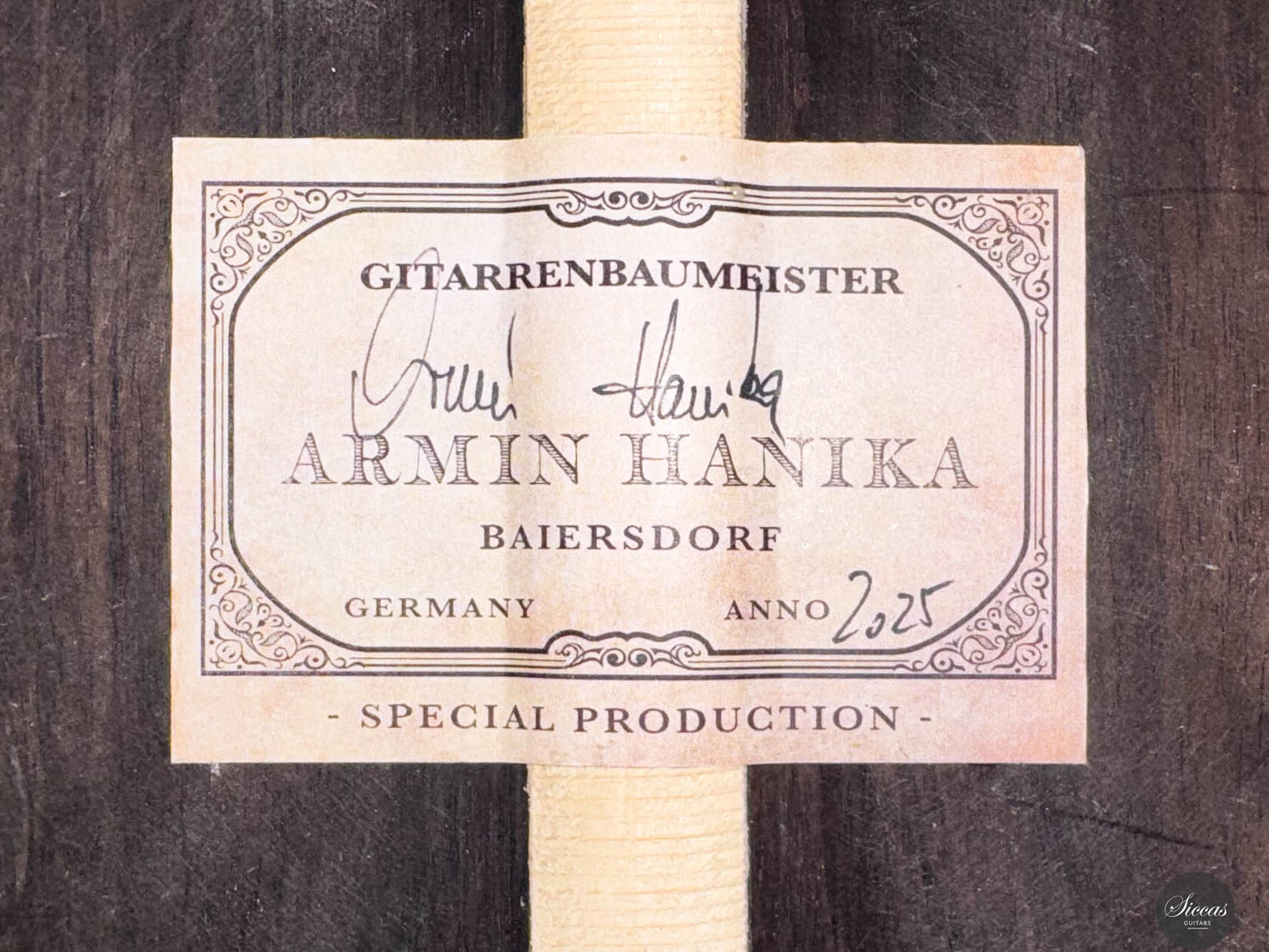Armin Hanika - 1a DTL Custom - Elevated fingerboard
Armin Hanika - 1a DTL Custom - Elevated fingerboard
Details
Details
Overview
Overview
Shipping important note
Shipping important note
Delivery times are typically reliable and most instruments arrive within the estimated timeframe.
Should any unexpected delay occur, our team will keep you informed and provide support at every step. For all shipping details and exceptions, please see our Shipping Policy.
Details about GPSR
Details about GPSR























Video overview


More details about the guitar
About the luthier
At Hanika, craftsmanship is regarded as precision work and sound as an art form. A guitar from this renowned Baiersdorf workshop stands for quality and a tradition of excellence. Since 1953, this philosophy has formed the foundation of the company’s success, paired with forward-thinking innovation. Master luthier Armin Hanika took over the family business in 1993 and has since been building classical guitars of outstanding quality.About the guitar
The 1a models represent the pinnacle of Armin Hanika’s guitar-making expertise, combining technical excellence, refined aesthetics, and tonal brilliance. This guitar features back and sides crafted from hand-selected Mexican Ziricote, paired with a double-top, lattice-braced soundboard made from perfectly split cedar. The arched top with lattice bracing maximizes resonance and responsiveness, while premium Alessi tuners reinforce the high standards that define the 1A Lattice series. Visually, the guitar stands out with a UV-cured high-gloss finish on the body and a hand-polished shellac finish on the top— an elegant and durable pairing. Sonically, the 1A DTL delivers impressive dynamics, rich tonal substance, clarity, and fast responsiveness. The careful selection of materials and high-level craftsmanship ensure that this concert guitar meets the needs of even the most demanding professional musicians. This model is a masterful example of contemporary design and performance, and in this custom setup, an excellent offer that retains the core value of the model.Regular care extends the life of the instrument
Even with careful use, a classical guitar may gradually change in appearance or respond to unstable storage conditions. Have a close look at your guitar regularly and be attentif to changes. If your instrument is suffering from its environement, it will let you know.
Protect Your Guitar: Handle with Care
Be mindful when touching your instrument with greasy or unwashed hands: any skin contact is a small attack on the varnish. Of course, a guitar is made to be played, but taking a few precautions helps preserve its beauty: wash your hands before playing, wear long sleeves, and avoid unnecessary direct skin contact with the body of the instrument.
Pro tip: Avoid playing with a button-up shirt, heavy jewelry, or a belt, as these can scratch the guitar. Also, make sure your guitar case is free of any objects that could damage the instrument during storage.
String care
A good habit to adopt is wiping down your strings briefly after each playing session. This small action significantly extends their lifespan and helps maintain a consistent, comfortable feel under your fingers.
Most importantly, clean strings are essential for keeping your instrument in tune. Corrosion, sweat, and dust can affect the uniformity of the strings and interfere with accurate tuning across the entire fingerboard.
Pro tip: If you're having trouble getting your guitar in tune, it might be time to change the strings. A useful test is to compare the pitch of the 12th fret harmonic with the fretted note at the 12th fret; if there's an unusually large gap between them, your strings may have lost their integrity and should be replaced.
Keep Your Shellac Finish Shining!
Got a guitar with a shellac (French polish) finish? Here's a simple trick: Take a clean microfiber cloth and gently breathe on the surface to create a light mist. Then, softly rub to remove fingerprints, sweat, and grease. That’s usually all it takes to keep it looking great, no products needed!
Pro tip: Every few years, treat your guitar to a check-up with a luthier to keep it in top shape.
Storing Your Guitar: Climate Matters
Your guitar can safely stay outside its case, as long as the surrounding environment maintains 42–55% humidity and a temperature between 18–25°C.
Keep in mind that humidity levels can still fluctuate inside the case, especially during seasonal changes.
- Too much humidity may cause overtightened strings and a dull tone.
- Too little humidity can lead to a bulging top, string buzz, or even cracks.
Avoid placing your guitar near radiators, air conditioners, or windows with direct sunlight.
Pro tip: Always close your guitar case while playing. This helps preserve a stable microclimate inside the case, so your instrument is protected the moment you put it back in.

















































